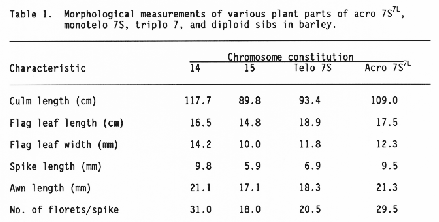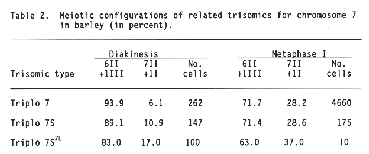

Available related trisomics for chromosome 7 (acro 7S7L , monotelo 7S, and triplo 7 in barley were studied to compare cytology and morphology of these aneuploid stocks with their diploid siblings.
Morphologically, acro 7S7L (2n=14+1 acrosomic 7S7L) was nearly indistinguishable from the diploid sibs (2n=2x=14), but was quite different from both triplo 7 (2n=2x+1=15) and monotelo 7S (2n=14+1 telosomic 7S). Table 1 shows measurements of various plant parts among the related trisomics and the diploid sibs. Ten plants of each type were measured.
Meiosis was studied at diakinesis and metaphase I in each of the related trisomics for chromosome 7. Triplo 7 had the highest frequency of the 6 II + 1 III configuration in both diakinesis and metaphase I and acro 7S7L had the highest occurrence of univalent formation. Triplo 7 and monotelo 7S were very similar for meiotic configuration at both diakinesis and metaphase I (Table 2).
It is hypothesized that greater occurrence of univalent formation in acro 7S7L is due to the small proximal fragment of the long arm of chromosome 7 present on the extra acrosomic chromosome.


References:
Furst, E., and T. Tsuchiya. 1983.BGN 13:47-48.
Tsuchiya, T., A. Shahla, and A. Hang. 1987. Barley Genetics V:389-395
Riley, R., and T. Tsuchiya. 1988.BGN 18:14-15.